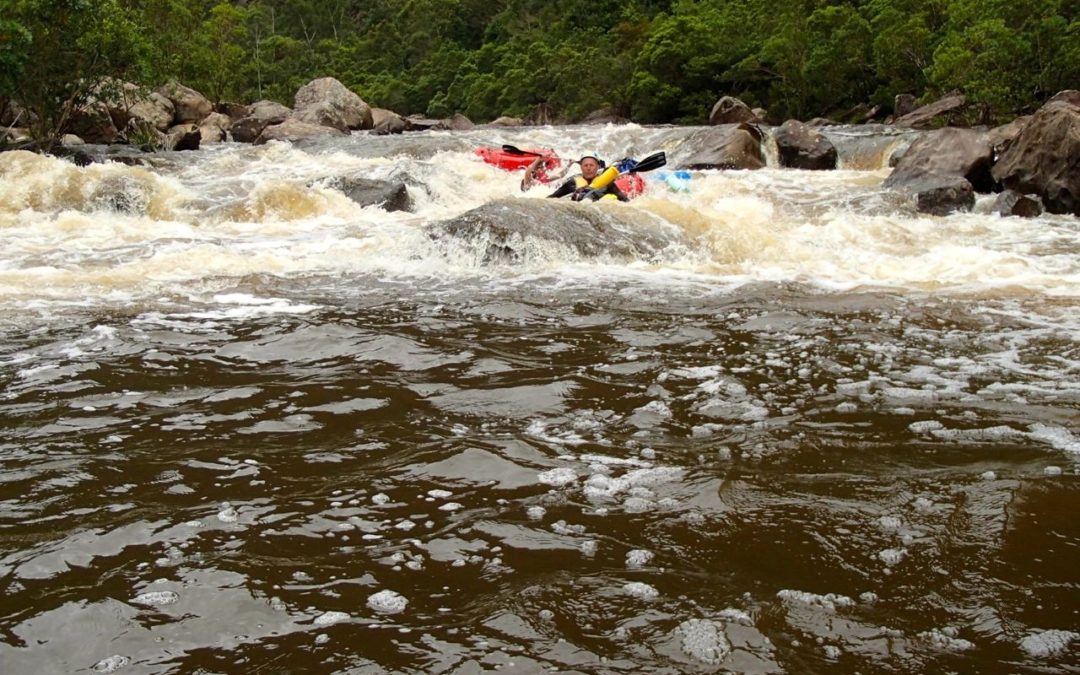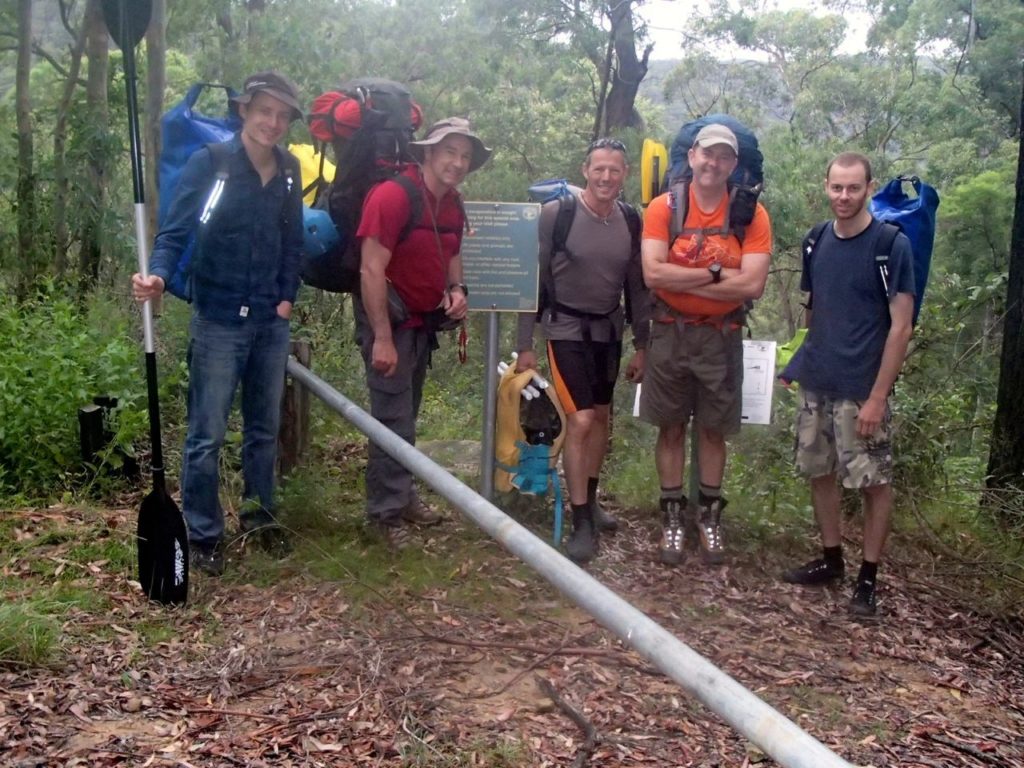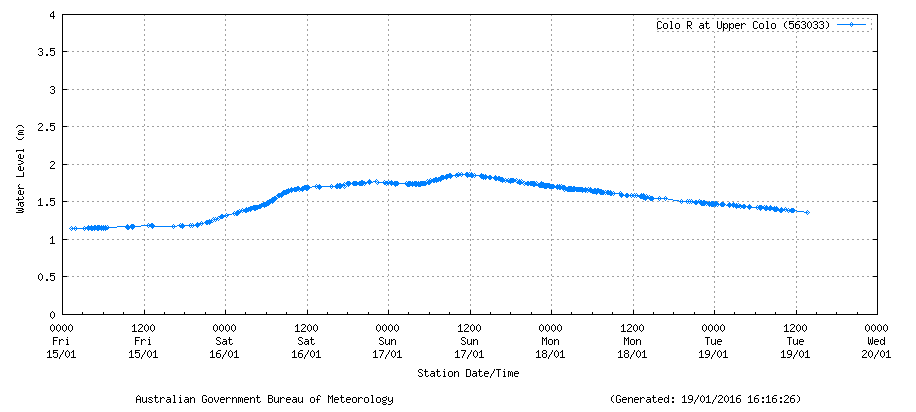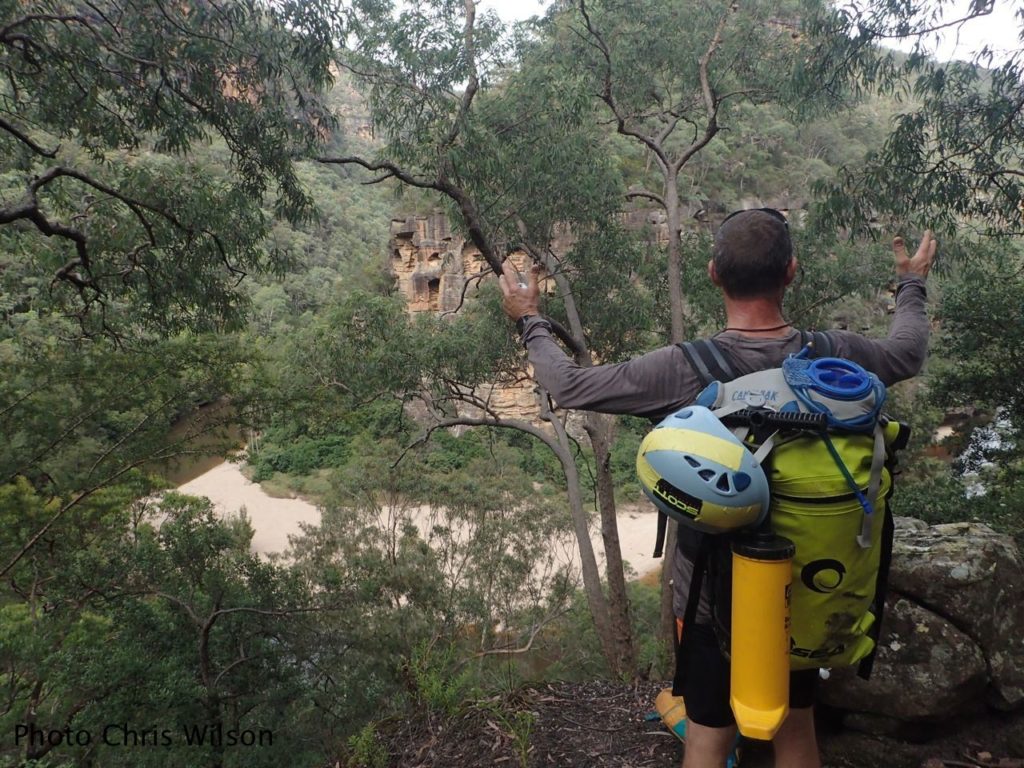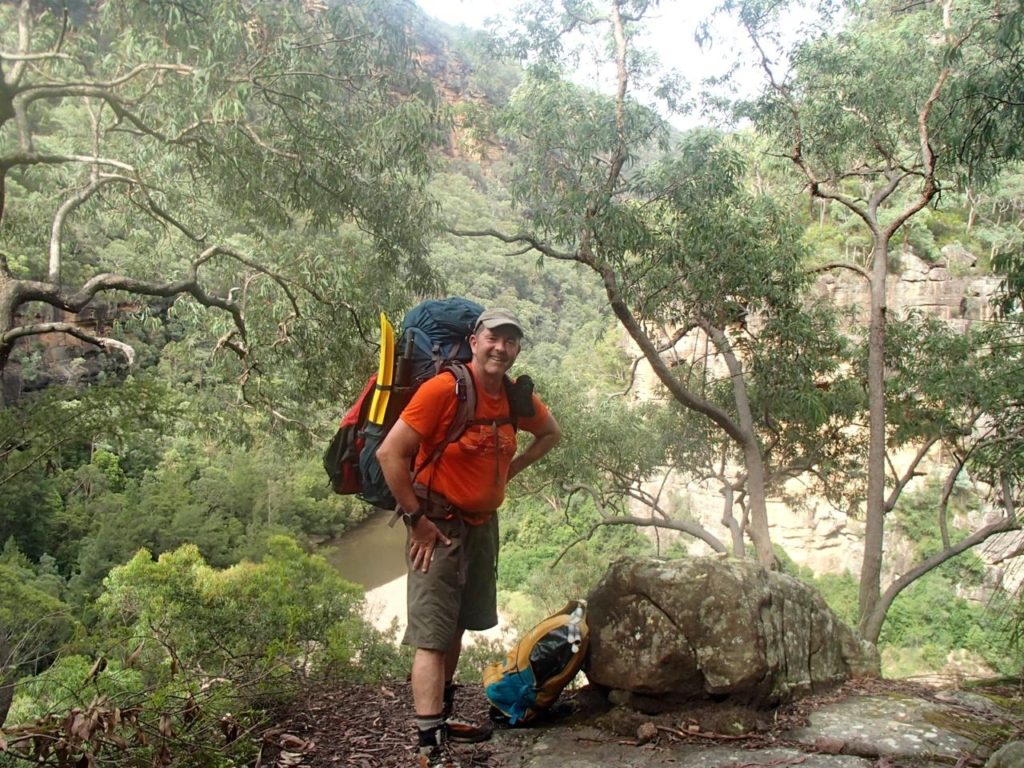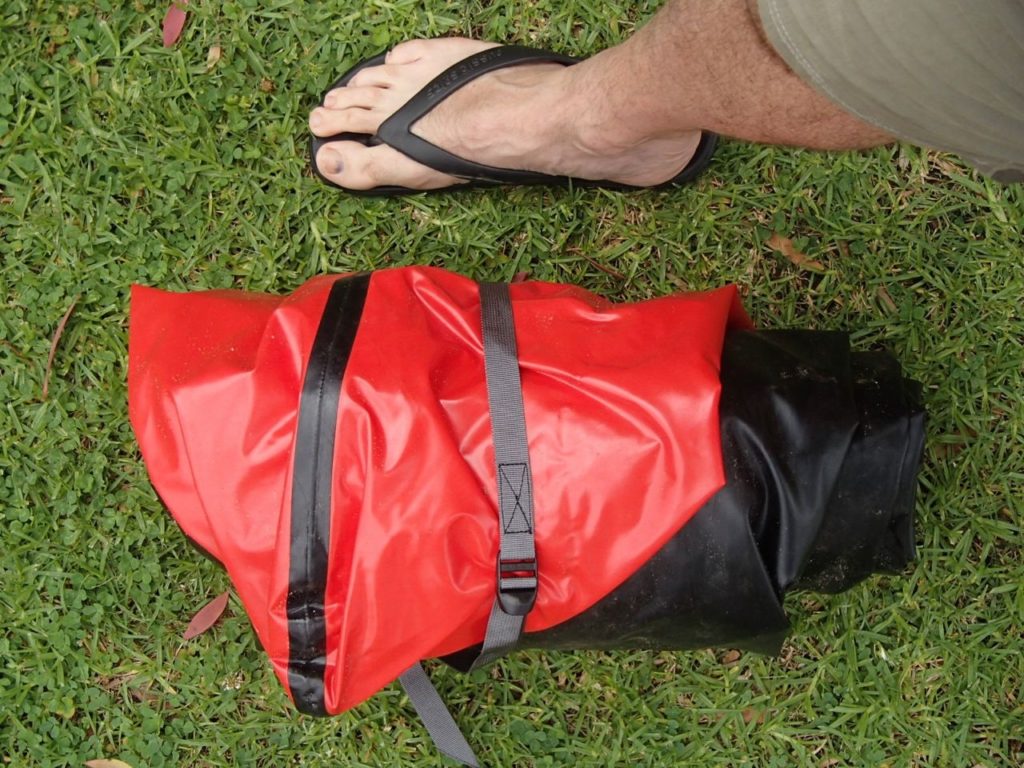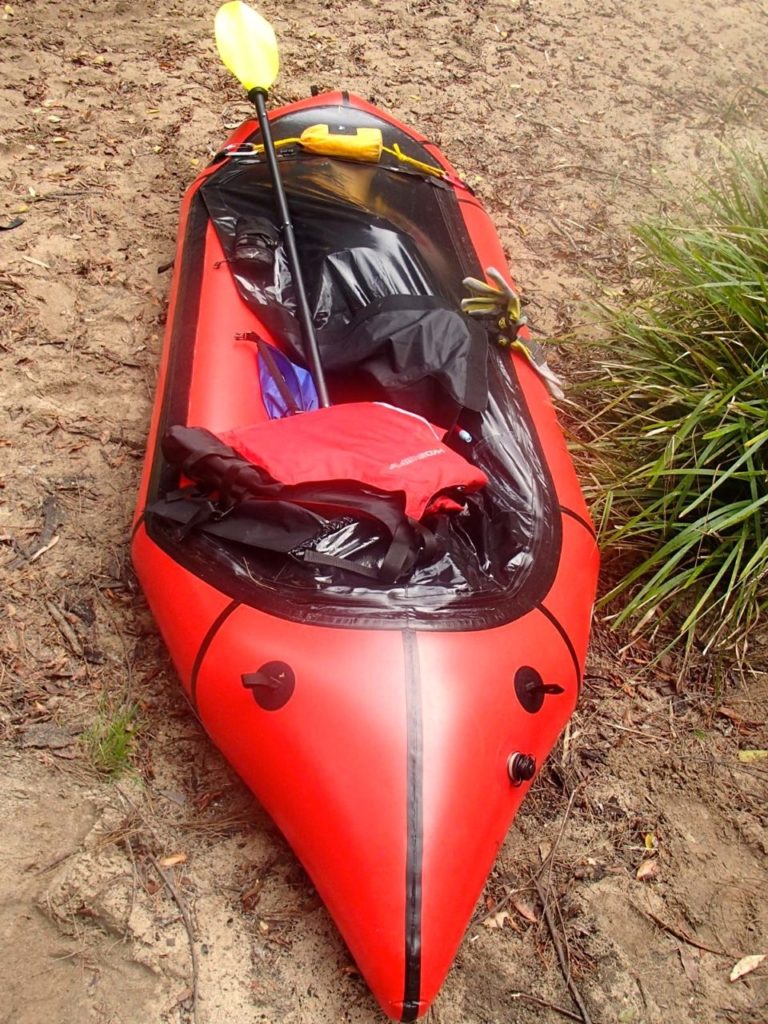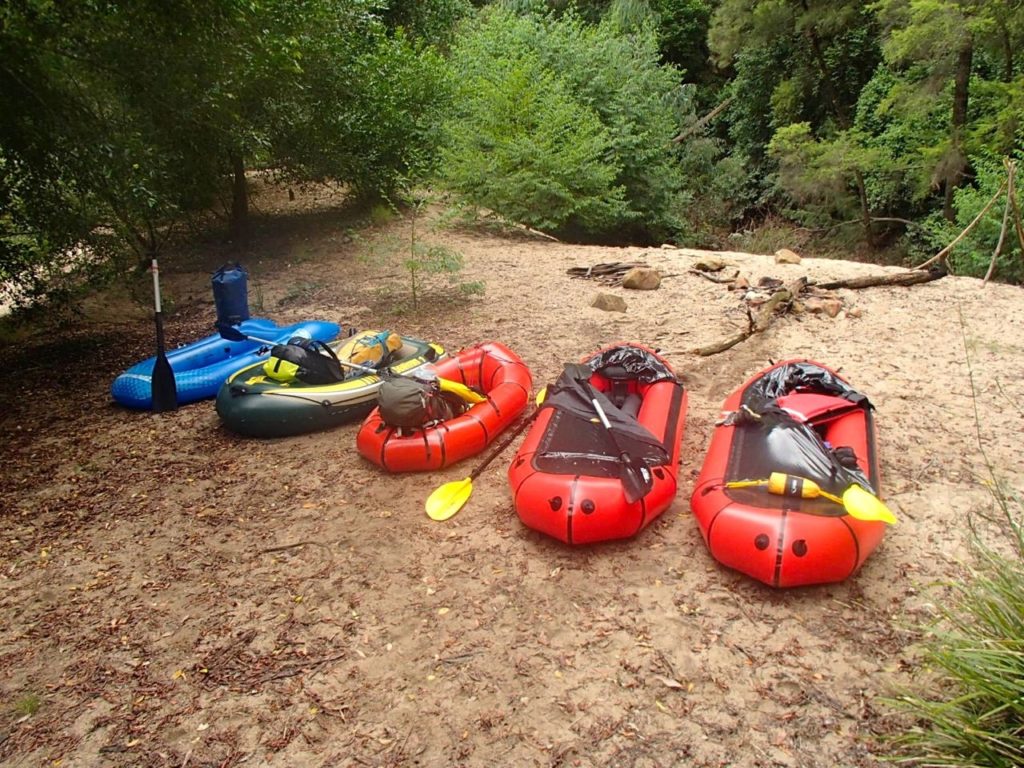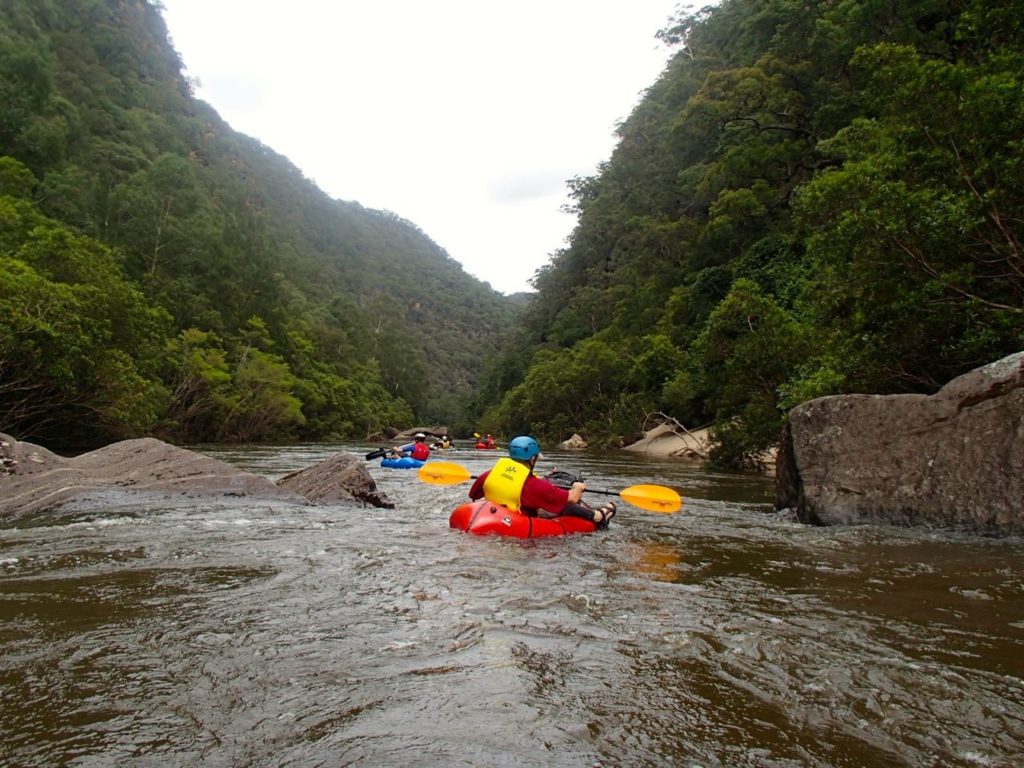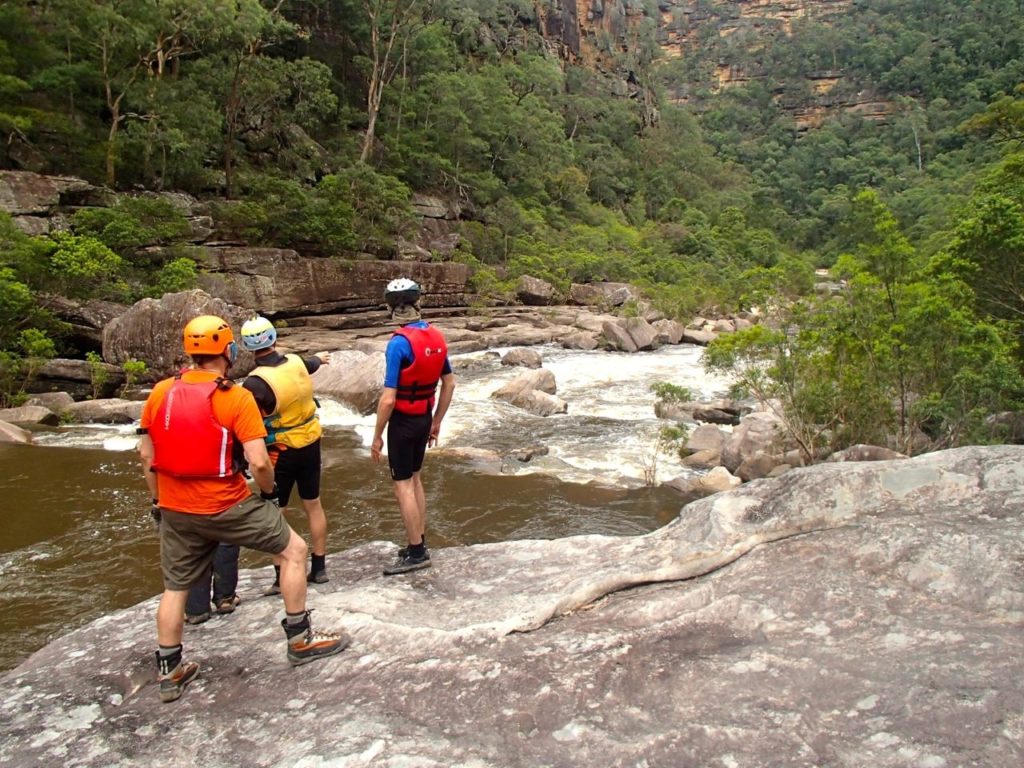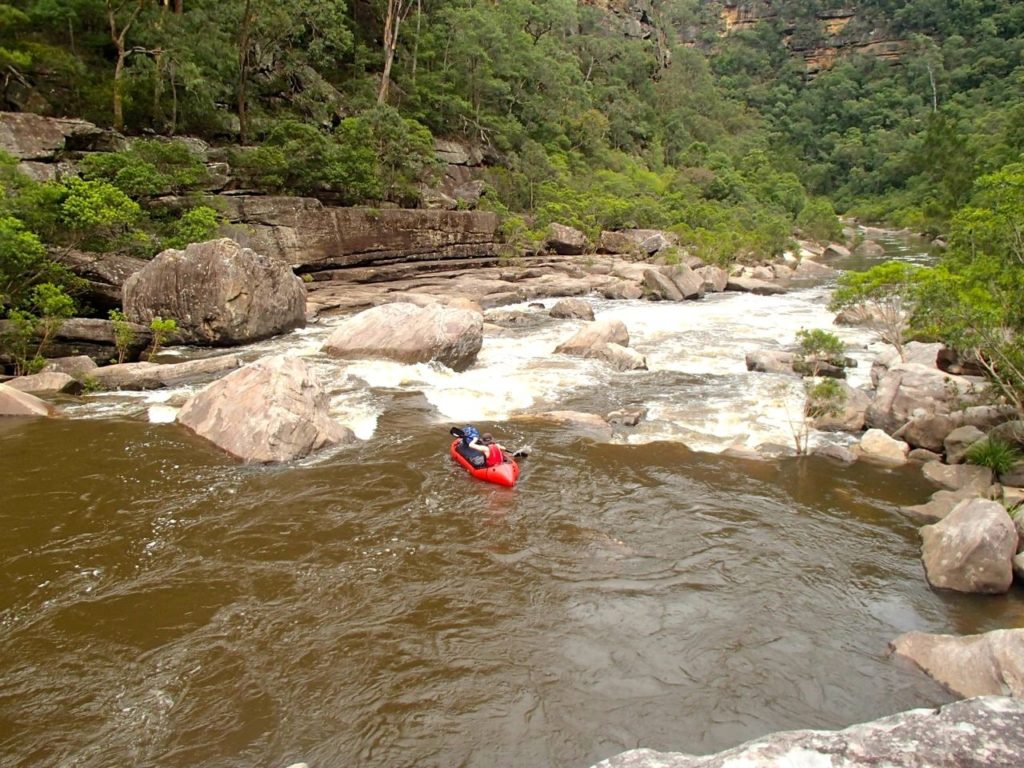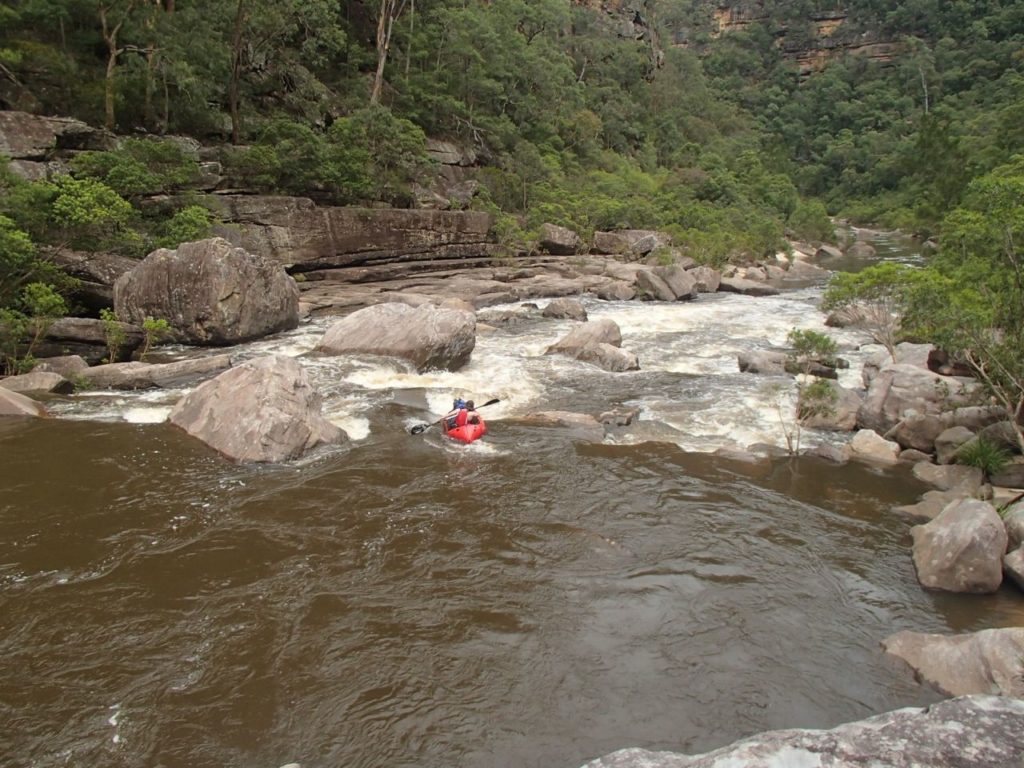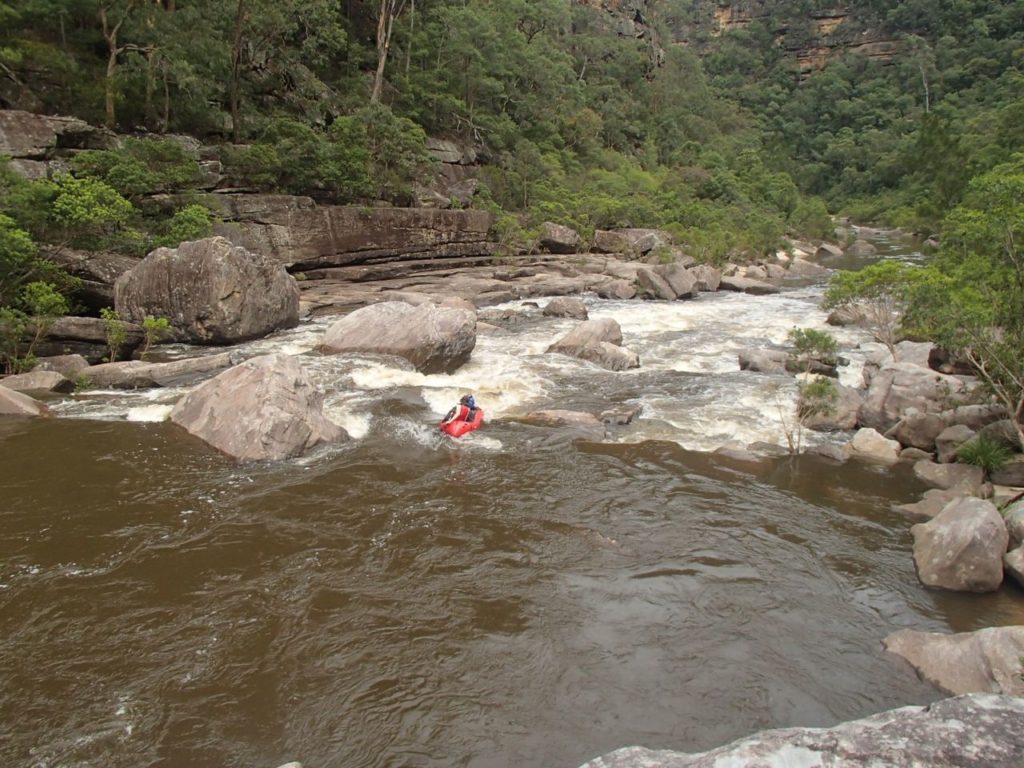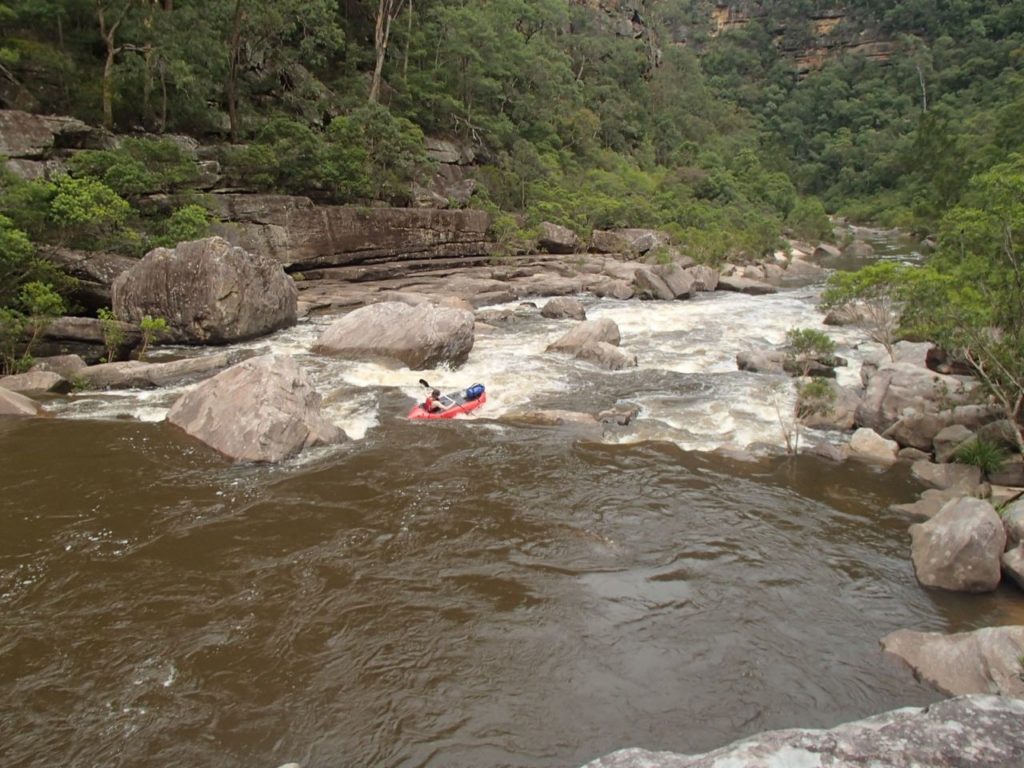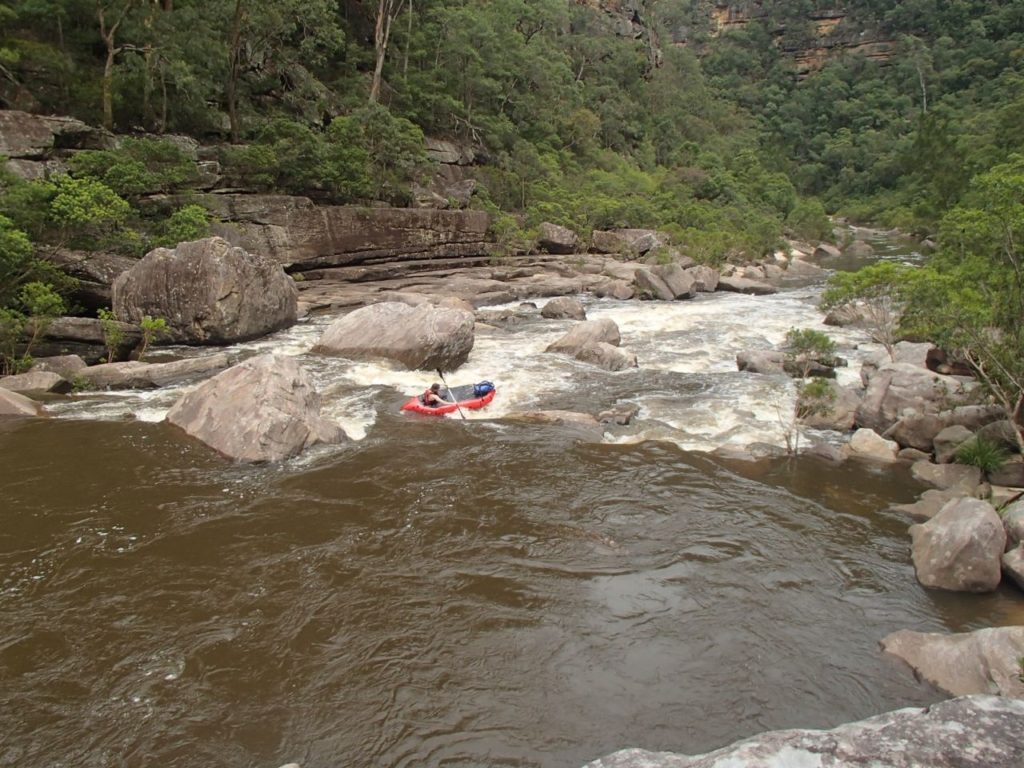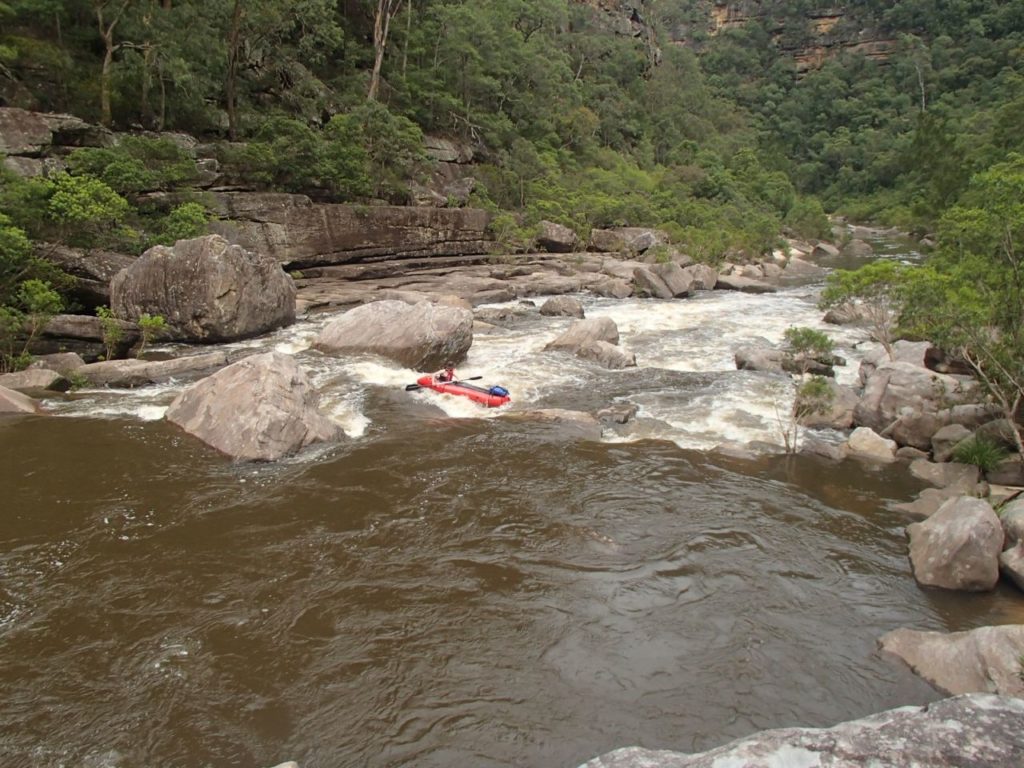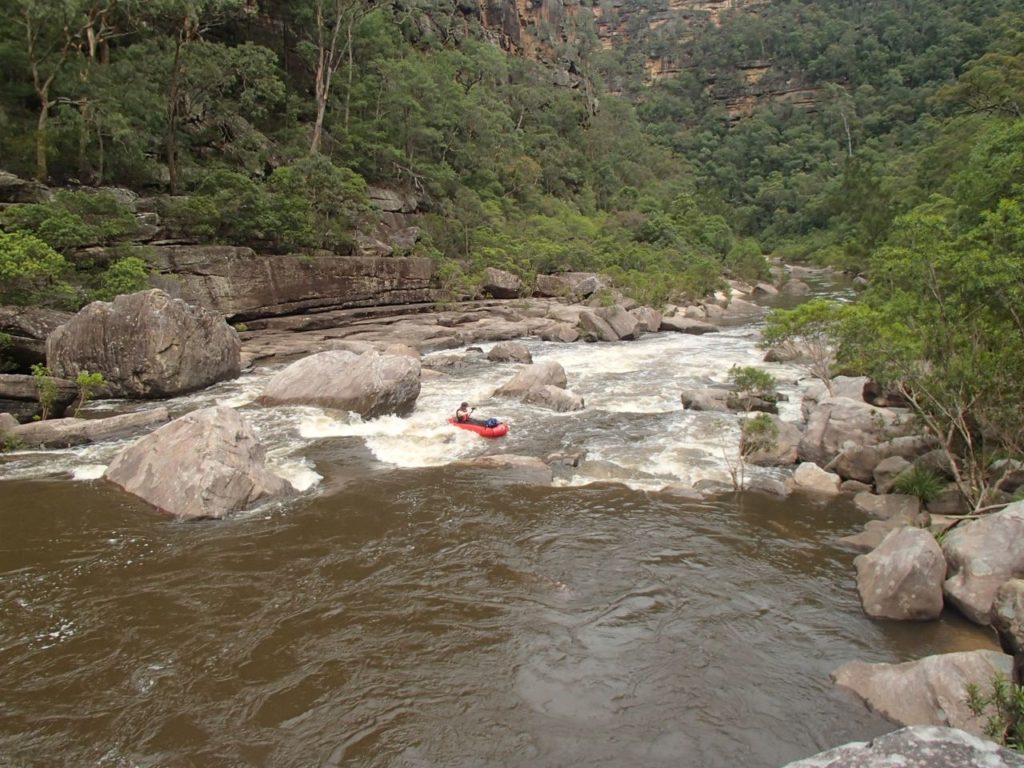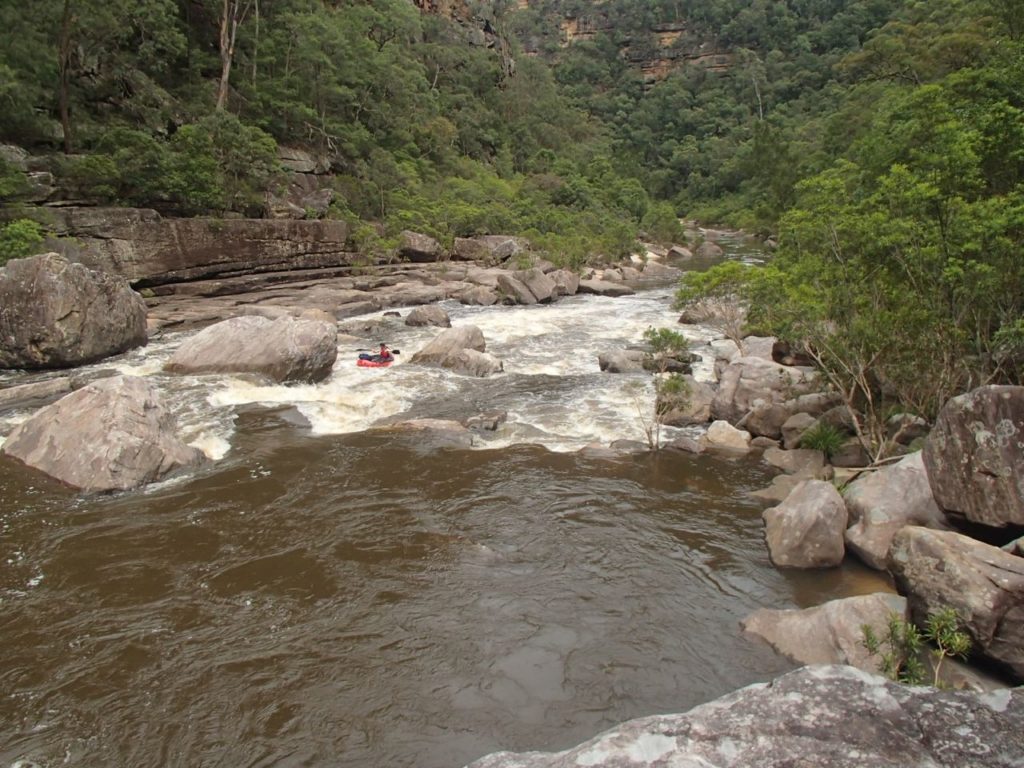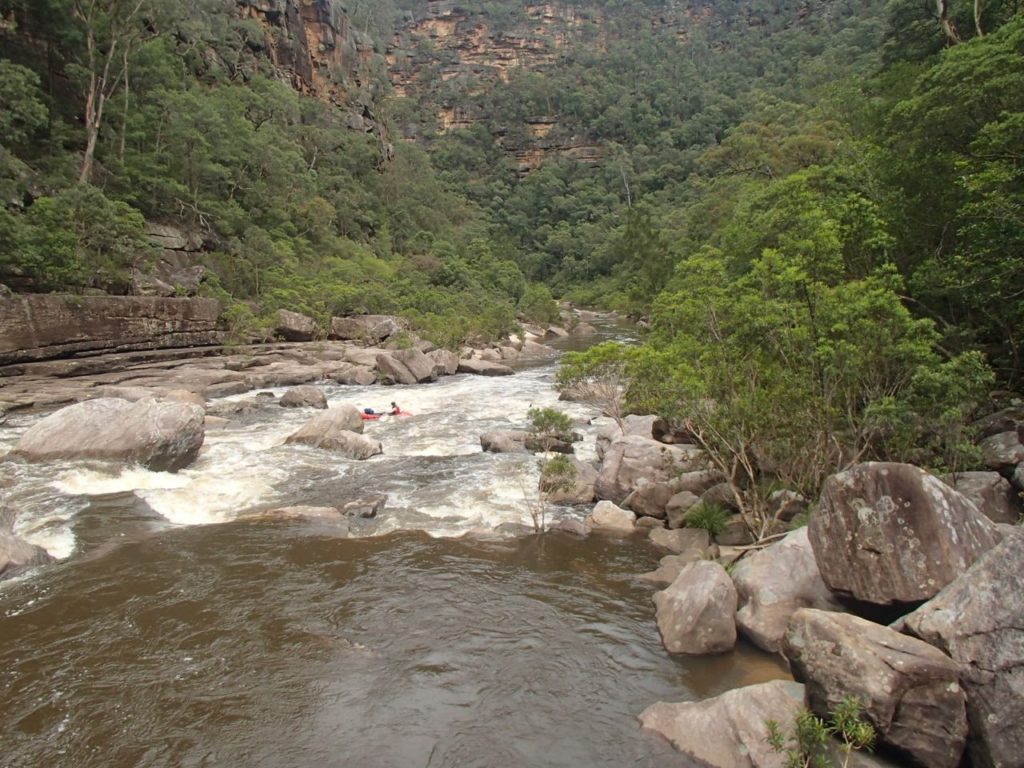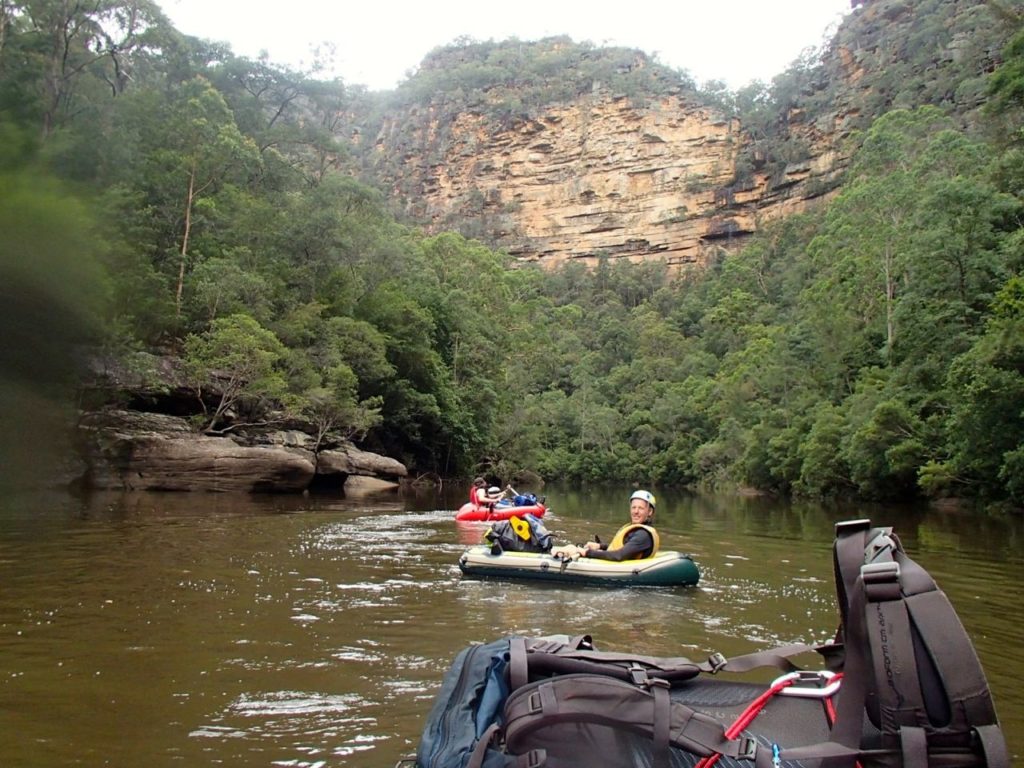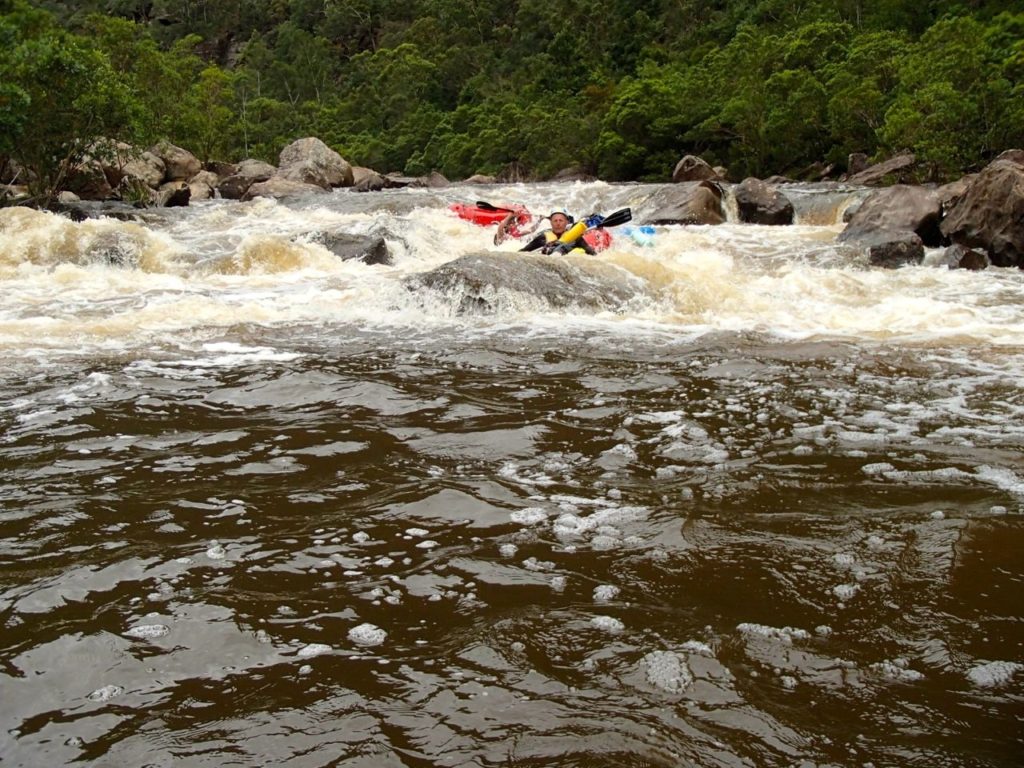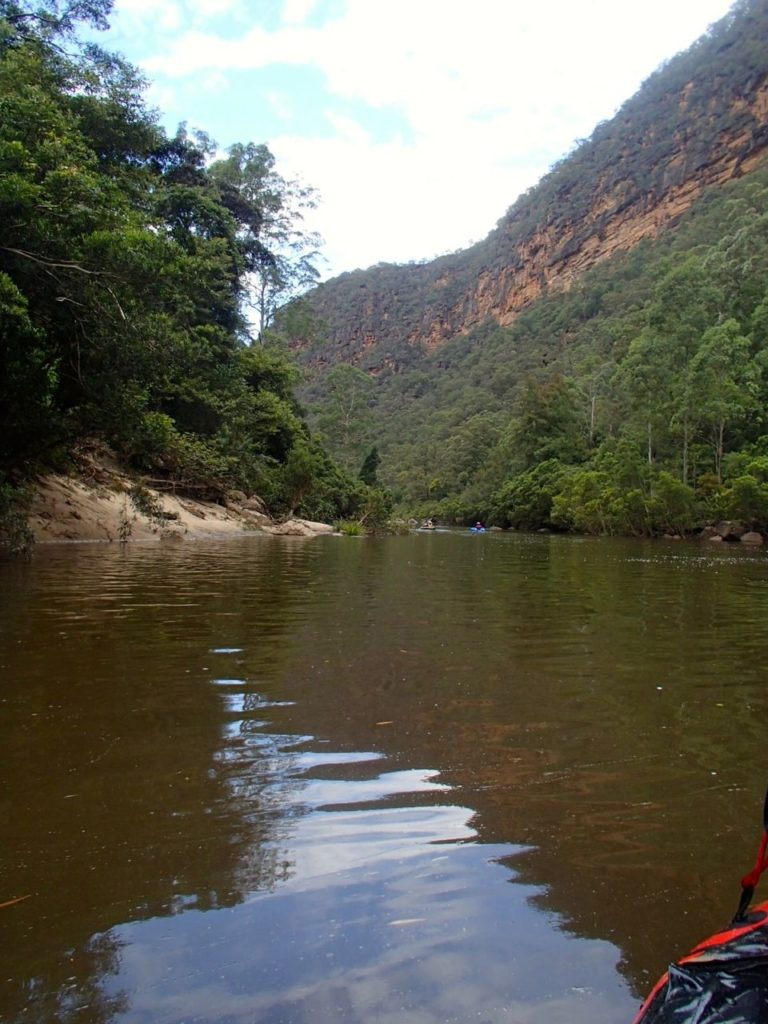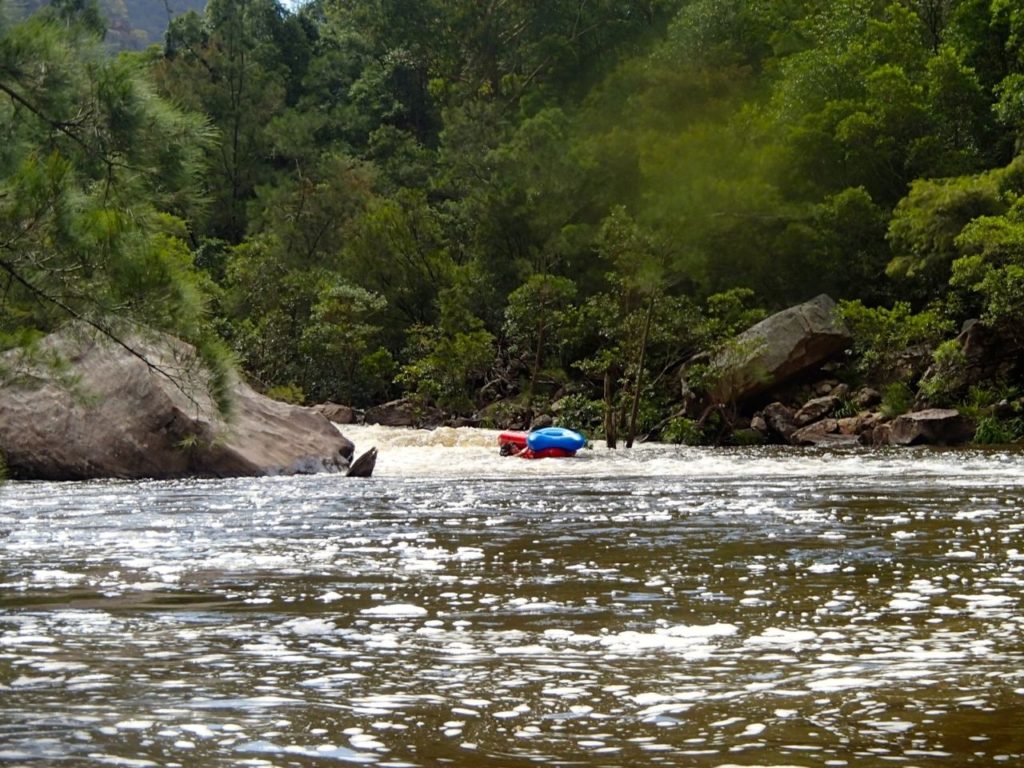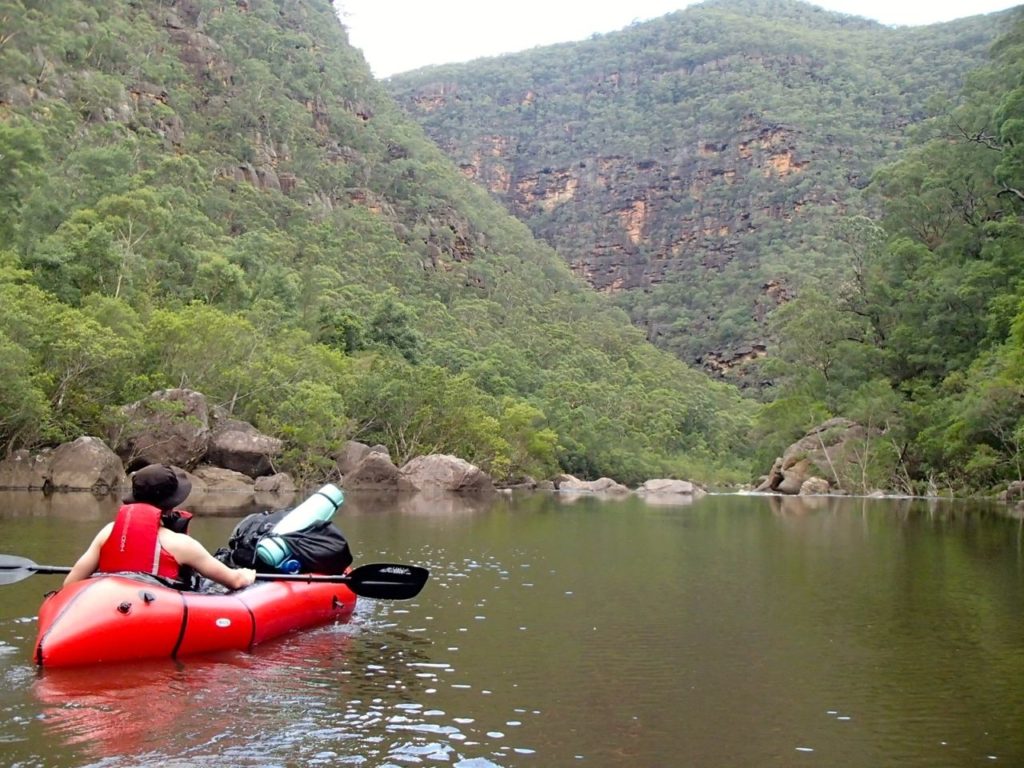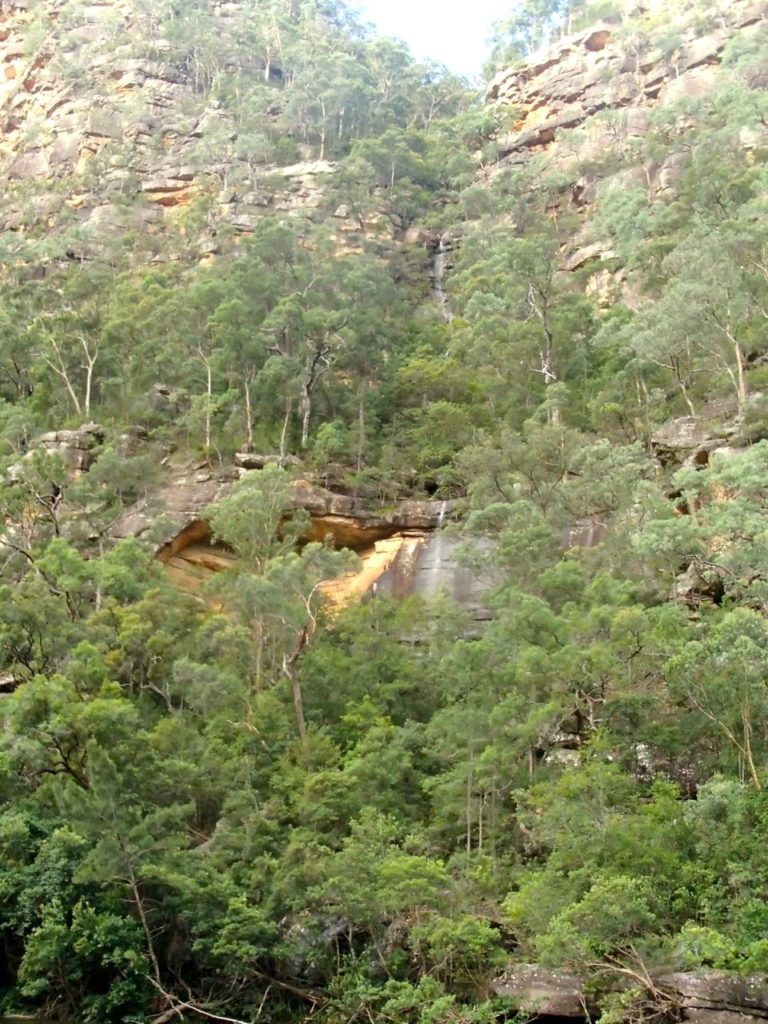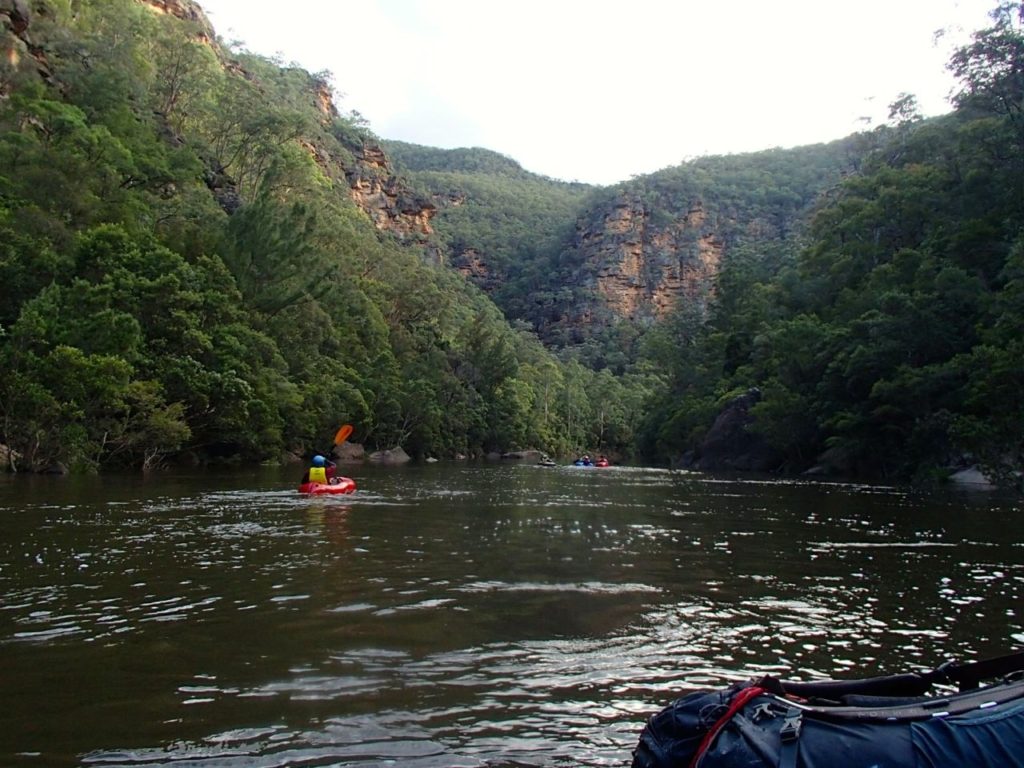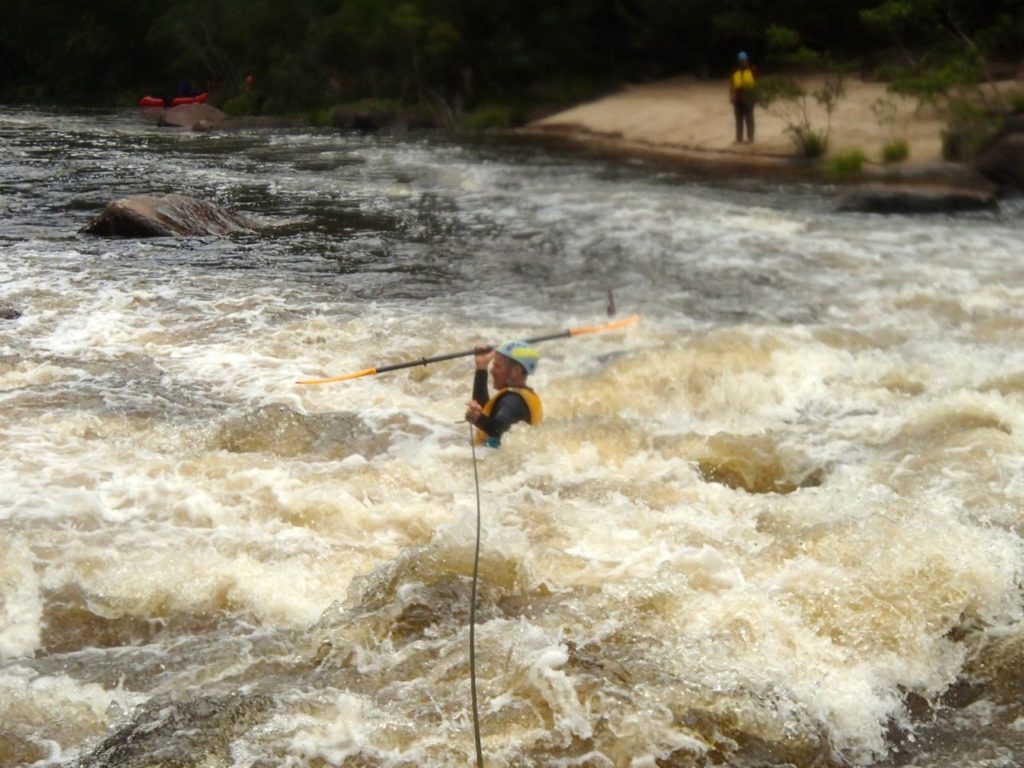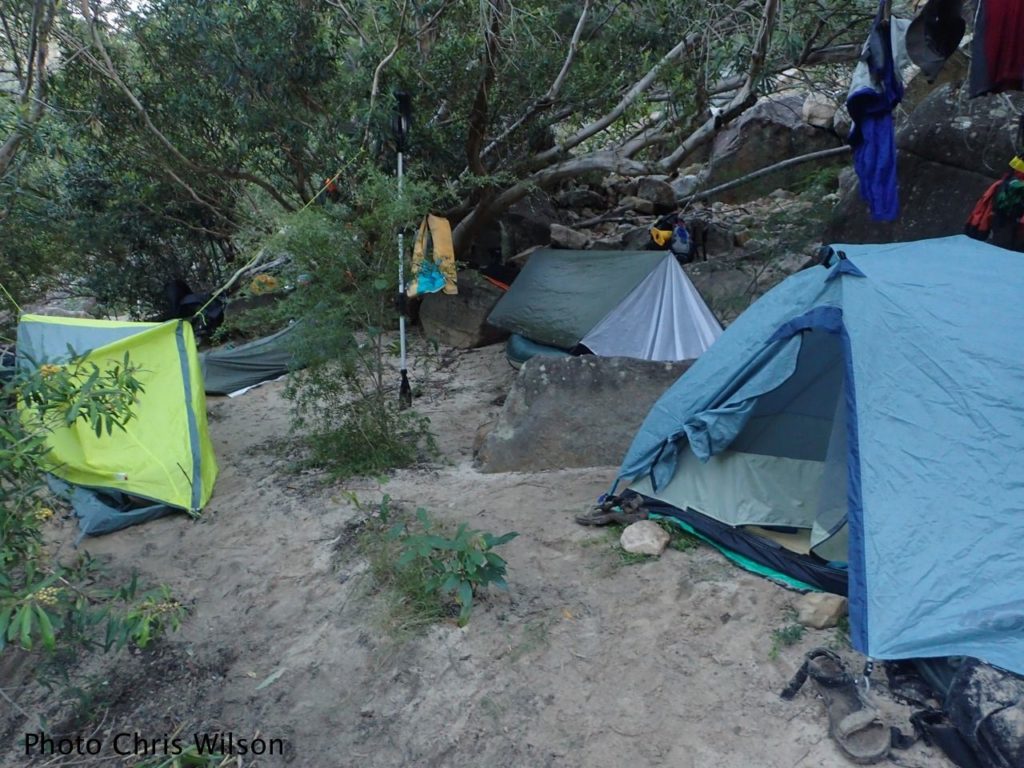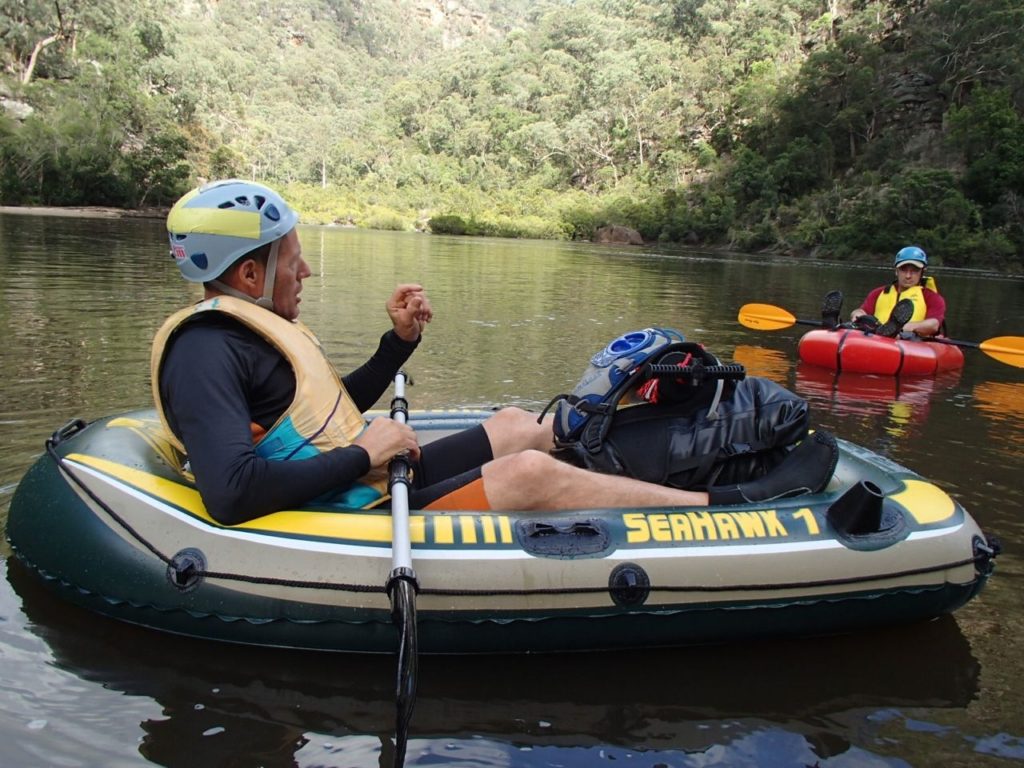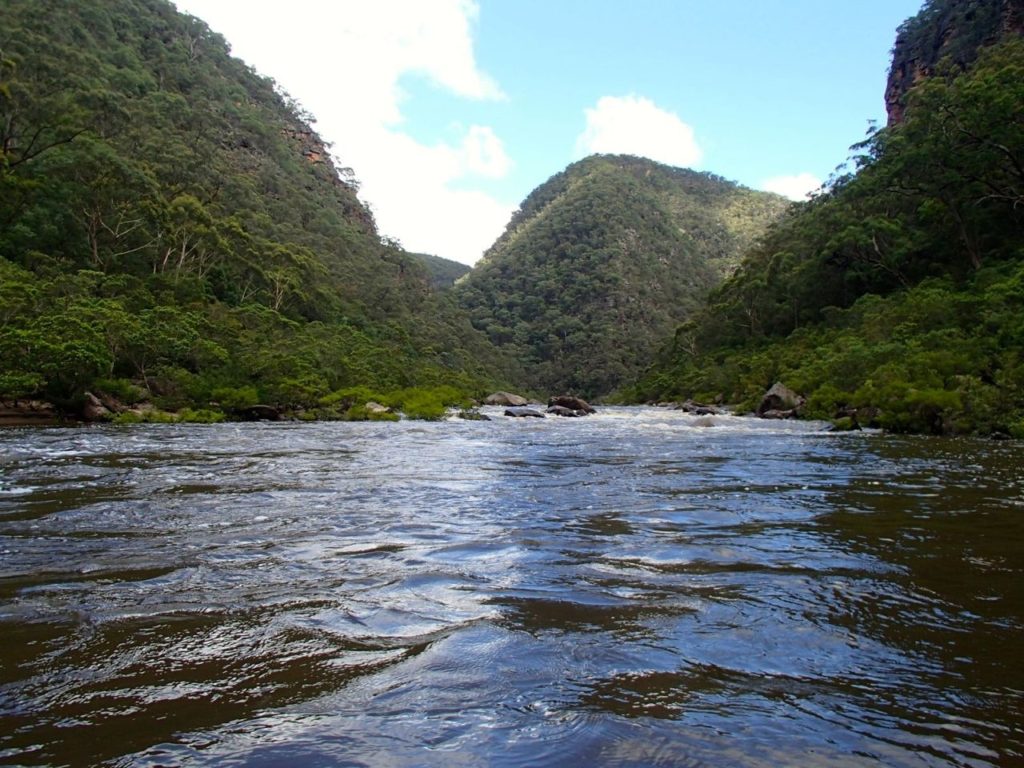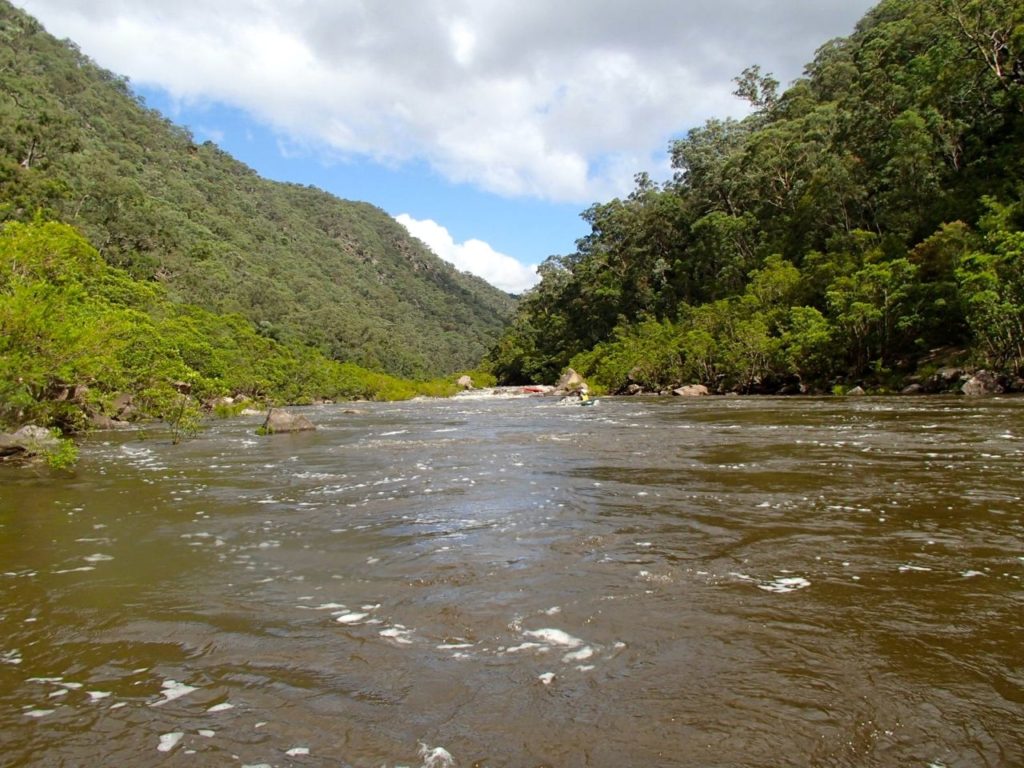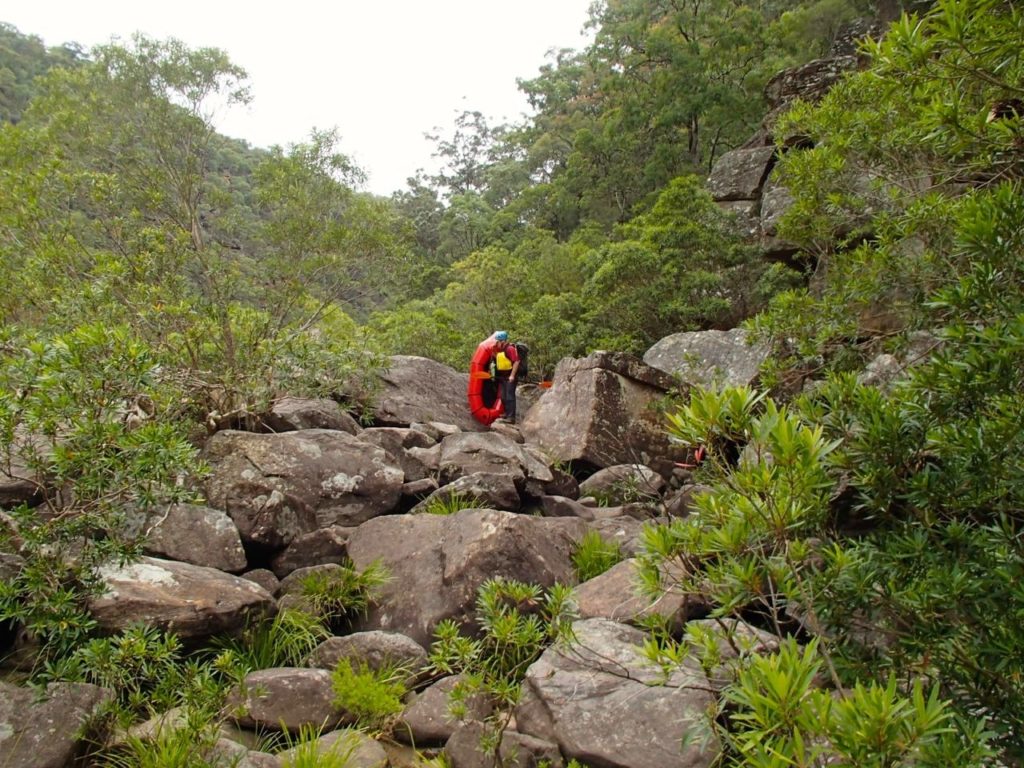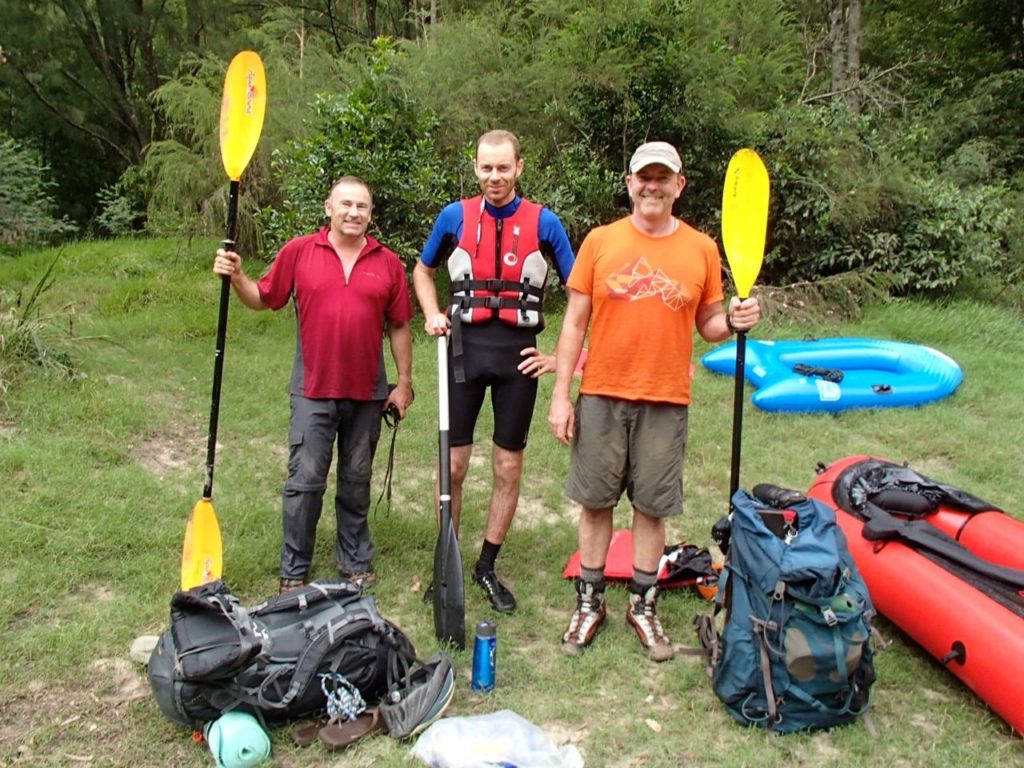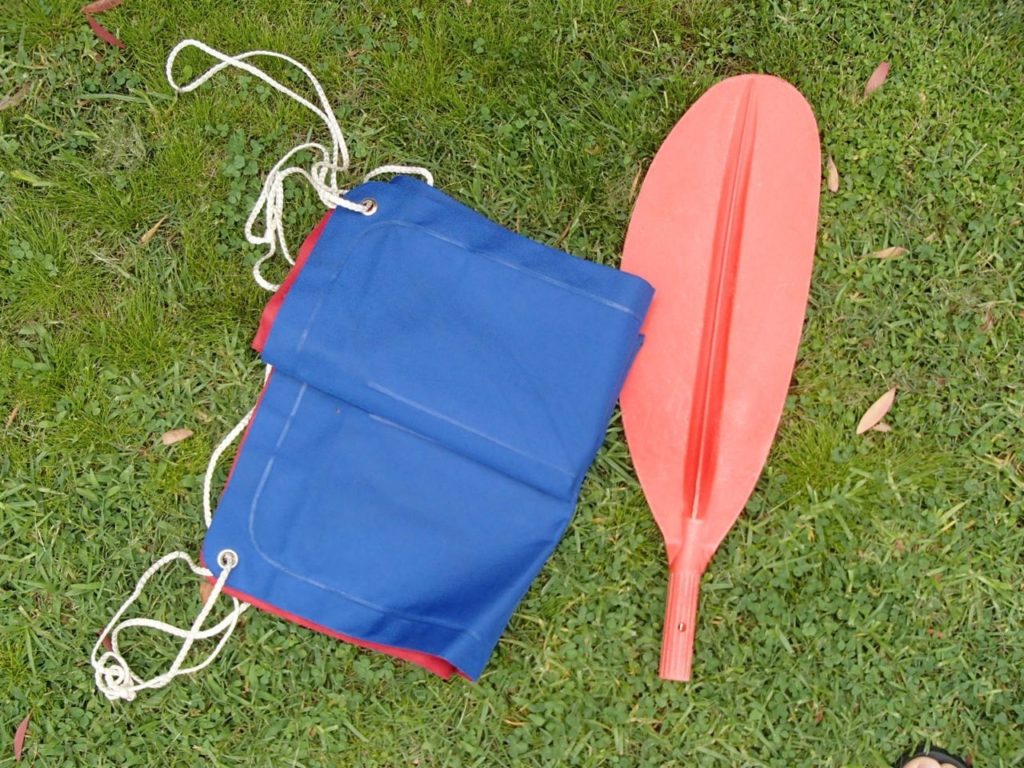Party: Glenn Chigley, Tim Fisher, Paul Griffiths (trip leader), Dean Smith, Chris Wilson.
Date: 15-17/01/2016
Original report: http://sonsofthedesert-abushwalkingblog.blogspot.com.au/2016/01/packrafting-colo-gorge.html
Our plan was to camp Friday night for an early start and do two full days in the river, covering about 50km. For reasons to be explained we ended up exiting after 28km at Bob Turner’s Track. We had standard problems with people being delayed, but in the end three of us ended up camping at the top of Canoe Creek Track, while Chris arrived next morning. About the same time Dean appeared up the track, having arrived first the evening before and spent the night in the excellent camping cave at the bottom with another party. Finally united, we set off down the steep but straightforward track at 8.00.
The flood gauge at Upper Colo had been reading a miserable 1.18m when we left Sydney, but as we came out above the river it was obvious it had come up substantially and the river looked be at an almost ideal height. Checking the gauge on our return we saw it was 1.67 when we started paddling, peaked at 1.85 on Sunday morning and was still 1.79 when we left the river.
It took about one and a half hours to walk down the Canoe Creek track to our first view of the river.
The walk would be a struggle with canoes, but is an easy stroll with packrafts. Paul’s pack in the picture below weighed 19kg including the boat and that was one of the heavier ones.
At the river we unpacked and inflated the rafts. This is an MRS Microraft rolled up:
And this is her inflated and ready to go. This is the extended version of the MRS, which can used as a 2-person canoe without the spraydeck. So it is heavy for a packraft: 3.6Kg including spraydeck. Paddle is about 1kg and lifejacket 400g, so the whole package is 5kg. Lots of information about them here.
The SUBW fleet consisted of three proper packrafts, a pair of MRS Extended Microrafts and an Alpacka Scout, and two cheap inflatables, the Mighty Seahawk (usually $69, but bought on special for $57) and the Mightbe Zambesi ($37).
The contrast between these two cheapies was instructive. The Intex Seahawk was robust, did not get a a single puncture, and handled the rapids as well as the proper packrafts. This was in large part due to it’s captain, Glenn, who was the most experienced paddler in the group. Nevertheless, it looked as if it would be OK in a class II rapid with anyone confident on board. The Zambesi, on the other hand, was little more than a pool toy. All credit to Dean for the performance he got out of it, but it was totally incapable of carrying a person and pack down a rapid intact and it was more like a lilo trip for Dean! It also
punctured whenever it saw a branch and by Sunday afternoon was richly decorated with Tyvek tape.
By 10.00 the mighty Suboir fleet had set sail, dominating the quiet waters of the Colo as thoroughly as the imperial fleet of the eunuch Zheng He once dominated the Pacific!
We soon encountered our first rapid, one of the larger ones we would see that day and more like a III than a II.
Paul followed, also in an MRS, got stuck on a rock on the last drop and capsized, fortunately at the very bottom of the rapid. Glenn and Chris came through OK and Dean portaged. The difference between the MRS rafts with spraydecks and the open Seahawk and Alpacka was immediately apparent. However well handled, the open rafts ended up full to the brim and had to be brought ashore and emptied after each rapid. You can see these later efforts in this film, taken by Tim:
The day then settled into very satisfying pattern, a kilometre or so of glassy paddling with sandstone cliffs towering hundreds of metres above us on either side, punctuated by occasional waterfalls, then the distant noise of the next rapid and a line of boulders appearing across the river. At each rapid a bit of scouting, then a couple of minutes of excitement for each of us, and then some cleaning up before resuming our travels. We lost count of the number of rapids, but there were something like fifteen before we reached the junction of the Wollongambe that evening.
It soon became clear that we were travelling slower than we had hoped. The Mightbe Zambesi was more inclined to turn circles than move forward. We tried swapping paddles, shunting it along from behind, and eventually towing, but the Zambesi (and its tug) were still falling hundreds of metres behind the other rafts on each reach. Portaging was also a major delay. Compared to the five minutes or so required to scout and run a rapid, it took an about 30m to complete a portage. We had two people portaging, as the limitations of the Alpacka Scout became apparent on about the third rapid, where Chris had a really nasty spill, coming out early and bouncing off a few rocks on the way down. Alpacka are the original and best packraft makers, and the Scout is a robust little boat, but it weighs in at 1.6kg rather than the 3kg of a standard packraft, and this is reflected in its buoyancy. It’s designed for river and lake crossing and explicitly rated only for Class I rapids.
Worse still, Chris’s paddle had disappeared somewhere in the rapid and was showing no signs of emerging. This led Glenn to carry out the day’s major act of heroics. Confident that he had seen where the paddle disappeared, he worked his way out from the side of the rapid with Paul and Dean holding him against the flow on a rope, hooked the paddle out with one foot and hurled it back to the bank with an elegant javelin throw. We had intended to bring a spare paddle, but this had already been handed to the person who had left his in Sydney (unnamed here as an act of mercy). In
Paddle recovered, we continued downriver, hoping to reach the Wollangambe junction, where Glenn remembered extensive sand flats to camp on. We tried various measures to speed up our progress, such as shifting Dean’s pack from the Mightbe Zambesi to Tim’s raft, and towing the two open rafts through rapids whilst Dean and Chris portaged without their boats. Late in the afternoon Paul broke his paddle in a rapid. leaving him with very long, single-ended paddle. This actually worked surprisingly well – the length of the handle made it much more effective that a normal T-bar single-ended paddle.
It was 7.00 before we saw the Wollangambe pouring in from the right-hand side. Predictably, the area had been reshaped by floods and sandbanks were in short supply, but a little scouting around revealed a sand bench a few metres above the river where, with a little digging, we could squeeze in five people. We could see the river rising and wondered what it would be like next morning. We were all pretty tired, so we ate a quick meal and retired for the night.
Sunday dawned bright and sunny and we were soon heading off down what was now a much wider river. Overnight Glenn had cut the rowlocks of the Mighty Seahawk as they get in the way when paddling.
As well as accommodating the combined flow of the Colo and Wollangambe, the valley itself was now wider, with less towering cliffs and more forested slopes.
The first, long reach was a delight with fast moving water and little class I rapids to speed us on our way. Nevertheless, after the first rapid we decided that we would definitely be pulling out at Bob Turner’s Track, which would mean hitching to fetch a car, so Tim and Glenn raced on ahead to get the car shuffle under way.
Both the fast and slow parties sensibly decided to portage past the King Rapid. This is at least Class IV and probably needs higher water to make it runnable at all. It’s an impressive sight, falling perhaps 10m in about 100m through giant boulders. At the bottom the racing water performs a full circle, carving out a decent sized circular lake with a little sand island with casuarinas in the middle, before heading off at ninety degree to it’s original direction of travel.
That morning we found the best solution to the Zambesi problem, inspired by the fact that Paul now had only half a paddle. We strapped the two rafts together with one person paddling each side, which worked so well that despite portaging the rapids we made decent time and arrived only a couple of hours after Tim and Glenn.
That’s Chris portaging around the King Rapid. Portaging in this part of the river is miserable and to be avoided at all costs. It means climbing over large boulders through dense water gums, scratching both yourself and the equipment. It’s at least 30m delay at each rapid.
After the King Rapid there are some long reaches, but just three more substantial rapids, II or II+, before the Bob Turner Track. The Mighty Seahawk is put to the test on one of these in this movie:
The slow party arrived at the bottom of Bob Turner’s Track at 5.00, where we found a family picknicking – the first people we had seen since Canoe Creek. Paul is hiding the fact that he only has three sections of his four-section paddle behind that rucksack. The helpful people at Packrafting-Store have since agreed to send a replacement blade, which is a lot better than buying a whole new one.
After a feed and packing up our rafts we started slogging up the hill on the well-made track around 6.00. We met a wild dog – not very wild, as it started following us – and near the top we suddenly heard music – was this the spirit of the bush we wondered? No – it was Tim walking down the track to meet us with his bluetooth iphone speakers. He dropped us back at the our cars and after a few farewells we were away down the Putty Road in the gathering dusk.
Packraft + Colo Gorge = classic trip. Highly recommended, but to be taken seriously. Here is some of the debris left by others that we found and took out with us.

